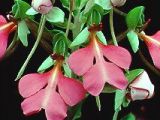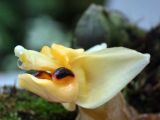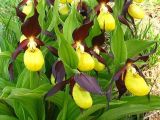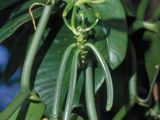You may not know, but if you are addicted to vanilla flavor, you're addicted to ... orchids.
Because the vanilla stick is nothing else than the fermented and blackened pod of an orchid, Vanilla planifolia, that occurs naturally in ... Mexico.
There are about 35,000 species of orchids in the world: about one eight of the flower plants in the world, and a peak of the plant evolution.
They live from the wet tropical forests to marshes, deserts, alpine pastures and rocks or polar tundras.
But the wet tropics remain their area of diversity, the richest zones in orchid species being the mountains and plains of north South America- Central America and southeastern Asia.
Wherever they grow, they need light, that's why most tropical orchids live as epiphyte over the trees' branches (used just as props) or rocks, fluttering their roots in the air while others open their flowers underground, without seeing sunlight. In temperate areas, orchids are terrestrial plants.
The shape of the orchids' flowers is extremely varied: some imitate bees, butterflies, or wasps; other can look like a little bird, lizards, frogs, monkey heads or a miniature human...
Habenaria blephariglottis from North America is named "monkey face", the Cycnoches genera from Central America are named "the swan orchids" because they look like a swan's neck.
Oncidium from tropical America is named torrito ("little bull" in Spanish) because it has two little "horns".
Cypripedium from northern temperate zone are named "lady slippers".
The beauty of the orchids flowers comes from their petals and petals positioned to make a nectariferous spur in order to attract pollinating insects. The lower petal is more developed, longer or wider, and often crispy. It often has a more vivid color, being different than the rest of the flower.
The smallest orchid plant could enter in a thimble, while the largest orchid can be a 30 m (100 ft) long vine.
Orchids expel perfume just during specific periods of the day or night, correlated to the activity of their pollinators and the environmental factors, to which these plants are very sensitive.
Orchids possess the smallest and most numerous seeds amongst flowering plants.
A seed weighs 3-14 micrograms and a sole capsule of Cycnodies ventricosum contains four million seeds!
Charles Darwin said that if each seed of a European orchid germinated, their offspring would cover the Earth in just three generations.
But till the beginning of the XX th century, botanists could not grow orchids from seeds. Orchids for collections in greenhouses had to be brought alive from the tropics. But in 1904 a French researcher found that orchid germination is not possible without a specific fungus.
Unlike other seeds, the orchid ones do not contain nutritive compounds and their development is linked to a microscopical fungus that invades them supplying the little seeds with food. The fungus was found to break down starch molecule to glucose.
Today orchids are also bred by meristem (embryonic tissue) cultures. From the orchid's bulb meristems are extracted and cultivated till the achievement of mature plants. This way, breeders achieve clones that can be multiplied countless times.
Artificial breeding is a way to save many wild orchids, savagely pillaged from nature. Vanilla is the only alimentary orchid, but others have medicinal uses.
In the Amboina Island (Indonesia) a paste made of Grammatophyllum is used against pains and in Malaya Dendrobium is employed against skin infections. In South Africa, Zulu use Habenaria, and Swazi the Lissochilus genera.
The tribes of Amazon employ Epidendrum bifidum, Spiranthes and there is a belief that these flowers protect people from diseases, that's why orchid hunts are often organized.
In Thailand, over 100 species are regularly cultivated.
Darwin found in the XIX th century in Madagascar an odd orchid from the Angraecum genera, A. sesquipedale. Which species could have pollinated the 30 cm (12 inch) long phonograph funnel like flower?
He predicted it must have been a moth with a large trunk. One century after, biologists found the moth: it had a 20 cm long trunk!
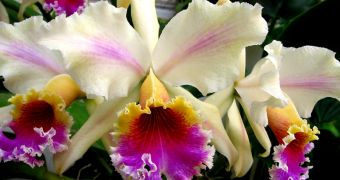
 14 DAY TRIAL //
14 DAY TRIAL // 
